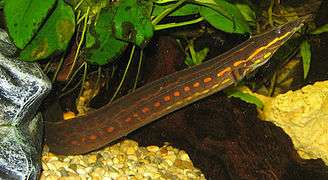Fire eel
| Fire eel | |
|---|---|
 | |
| Scientific classification | |
| Kingdom: | Animalia |
| Phylum: | Chordata |
| Class: | Actinopterygii |
| Order: | Synbranchiformes |
| Family: | Mastacembelidae |
| Genus: | Mastacembelus |
| Species: | M. erythrotaenia |
| Binomial name | |
| Mastacembelus erythrotaenia Bleeker, 1850[2] | |
The fire eel (Mastacembelus erythrotaenia) is a relatively large species of spiny eel. This omnivorous freshwater fish is native to in Southeast Asia but also found in the aquarium trade.[1][3] Although it has declined locally (especially in Thailand) because of this trade and overfishing, it remains common overall.[1]
Description
The fire eel is not a true eel, but an extremely elongated fish with a distinctive pointed snout and underslung mouth. It is part of a group of fishes called spiny eels that also includes tire track and peacock eels. The group gets its common name from the many small dorsal spines that precede the dorsal fin.
The body is laterally compressed, particularly the rear third, where it flattens as it joins the caudal fin and forms an extended tail. The fire eel's base coloring is dark brown/grey, while the belly is generally a lighter shade of the same color. Several bright red lateral stripes and spots mark the body and vary in intensity depending on the age and condition of the individual. Usually, the markings are yellow/amber in juvenile fish, changing to a deep red in larger ones. Often the anal, pectoral, and dorsal fins have a red edging.
The fire eel is the largest species in its family and can reach up to 1 m (3.3 ft) in length.[4][5][6][7]
Range, habitat, diet, and behavior
Fire eels occur across a relatively broad area covering a large part of lowland Southeast Asia, including Myanmar, Thailand, Vietnam, Peninsular Malaysia, Borneo (Indonesia and Malaysia), and Sumatra (Indonesia).[1][3] They inhabit slow-moving rivers and flood plains, and are bottom-dwellers that typically are found in places with a muddy bottom.[1][3] They spend large portions of their time buried in the riverbed, often leaving only their snout visible.
The fire eel feeds on invertebrates (such as insect larvae, worms, and crustaceans), smaller fish, plant matter, and detritus.[3][6] In captivity, it is difficult to get them to eat plant matter.[8]
References
- 1 2 3 4 5 Vidthayanon, C. (2012). "Mastacembelus erythrotaenia". IUCN Red List of Threatened Species. Version 2017.1. International Union for Conservation of Nature. Retrieved 11 April 2017.
- ↑ "BioLib - Mastacembelus erythrotaenia". BioLib. Retrieved 24 May 2012.
- 1 2 3 4 Froese, Rainer and Pauly, Daniel, eds. (2017). "Mastacembelus erythrotaenia" in FishBase. April 2017 version.
- ↑ Froese, Rainer, and Daniel Pauly, eds. (2017). Species of Mastacembelus in FishBase. April 2017 version.
- ↑ "Mastacembelus erythrotaenia (Fire Eel)". Seriously Fish. Retrieved 2017-07-12.
- 1 2 SeriouslyFish: Mastacembelus erythrotaenia. Retrieved 11 April 2017.
- ↑ "The Fire Eel: Care Information". AquariaCentral.com. Retrieved 2017-07-12.
- ↑ "Mastacembelus erythrotaenia (Fire Eel)". Seriously Fish. Retrieved 2017-07-12.
